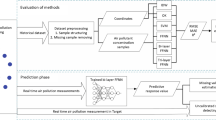Abstract
The monitoring and microclimate controlling in urbanized areas become one of the research hotspots in the field of air quality, where the application of Wireless Sensor Networks (WSN) recently attracts more attention due to its features of self-adaption, resilience, and cost-effectiveness. Present microclimate monitoring and control systems achieve their prediction by manipulating captured environmental factors and traditional neural network algorithms. However, these systems have a problem to solve the challenges of the quick prediction (e.g. hourly and even minutely) when the WSN network is deployed. In this paper, a novel prediction method based on a combination of Extended Kalman Filter (EKF) and an Extreme Learning Machine (ELM) algorithm is proposed to predict the key microclimate parameters like temperature, humidity, and barometric pressure level in a city urbanized areas. The outdoor air temperature, humidity, and barometric pressure in the air are measured as data samples via WSN based clusters managed by custom design operator stations. The results of the realized model simulation show that the processing speed rate of the proposed prediction model is significantly higher than other ANN-based models at a relatively good level of precision.
Access this chapter
Tax calculation will be finalised at checkout
Purchases are for personal use only
Similar content being viewed by others
References
UNFPA: 7e state of world population YZDD. Report of the United Nations Population Fund, New York, NY, USA (2011)
Ng, E., Chen, L., Wang, Y., Yuan, C.: A study on the cooling effects of greening in a high-density city: an experience from Hong Kong. Build. Environ. 47, 256–271 (2012)
White, R., Engelen, G., Uijee, I.: The use of constrained cellular automata for high-resolution modelling of urban land-use dynamics. Environ. Plan. 24, 323–343 (1997)
Gar-On Yeh, A., Li, X.: Urban simulation using neural networks and cellular automata for land use planning. Int. J. Geogr. Inf. Sci. 16, 323–343 (2002)
Alkheder, S., Shan, J.: Cellular Automata Urban Growth Simulation and Evaluation-A Case Study of Indianapolis, Geomatics Engineering, School of Civil Engineering, Purdue University (2005). http://www.geocomputation.org/2005/Alkheder.pdf (14) (PDF) Investigation of Urban Sprawl using Remote Sensing and GIS: A case of Onitsha and its Environs. Available from: https://www.researchgate.net/publication/259391154Investigation of Urban Sprawl using Remote Sensing and GIS A case of Onitsha and its Environs
Menard, A., Marceau, D.J.: Exploration of spatial scale sensitivity in geographic cellular automata. Environ. Plan. 32, 693–714 (2005)
Maqsood, I., Khan, M.R., Abraham, A.: An ensemble of neural networks for weather forecasting. Neural Comput. Appl. 13, 112–122 (2004)
Ruano, A.E., Crispim, E.M., Conceicão, E.Z.E., Lucio, M.M.J.R.: Prediction of building’s temperature using neural networks models. Energy Build. 38, 682–694 (2006)
Tasadduq, I., Rehman, S., Bubshait, K.: Application of neural networks for the prediction of hourly mean surface temperatures in Saudi Arabia. Renew. Energy 36, 545–554 (2002)
Santamouris, M., Paraponiaris, K., Mihalakakou, G.: Estimating the ecological footprint of the heat Island effect over Athens. Greece Clim. Change 80, 265–276 (2007)
Mihalakakou, M., Santamouris, N., Papanikolaou, C.: Cartalis simulation of the urban heat Island phenomenon in Mediterranean climates. Pure Appl. Geophys. 161, 429–451 (2004)
Kolokotroni, M., Davies, M., Croxford, B., Bhuiyan, S., Mavrogianni, A.: A validated methodology for the prediction of heating and cooling energy demand for buildings within the urban heat island: case-study of London. Solar Energy 84(12), 2246–2255 (2010)
Heeswijk, M.: Advances in Extreme Learning Machines, Aalto University publication series, 43/2015, pp. 13–17. ISBN 978-952-60-6148-1
Huang, B., Zhu, Q.Y., Siew, C.-K.: Extreme learning machine: a new learning scheme of feedforward neural networks. In: Proceedings of the 2004 IEEE International Joint Conference on Neural Networks, vol. 2, pp. 985–990 (2004)
Gu, B., Sheng, V.S., Tay, K.Y., Romano, W., Li, S.: Incremental support vector learning for ordinal regression. IEEE Trans. Neural Netw. Learn. Syst. 26(7), 1403–1416 (2015)
Gu, B., Sheng, V.S., Wang, Z., Ho, D., Osman, S., Li, S.: Incremental learning for v-support vector regression. Neural Netw. 67, 140–150 (2015)
Huang, G.-B., Zhu, Q.-Y., Siew, C.-K.: Extreme learning machine: a new learning scheme of feedforward neural networks. In: IEEE Proceedings of International Joint Conference on Neural Networks, pp. 985–990 (2004)
Kalman, R.E.: A new approach to linear filtering and prediction problems. J. Basic Eng. 82(1), 35–45 (1960)
Patil, S.L., Tantau, H.J., Salokhe, V.M.: Modelling of tropical greenhouse temperature by auto regressive and neural network models. Biosyst. Eng. 99(3), 423–431 (2008)
Shao, B., Zhang, M., Mi, Q., Xiang, N.: Prediction and visualization for urban heat island simulation. In: Transactions on Edutainment VI, pp. 1–11. Springer (2011)
Acknowledgements
This paper is supported by the National Scientific Program “Information and Communication Technologies for a Single Digital Market in Science, Education and Security (ICTinSES)”, financed by the Ministry of Education and Science.
Author information
Authors and Affiliations
Corresponding author
Editor information
Editors and Affiliations
Rights and permissions
Copyright information
© 2021 The Editor(s) (if applicable) and The Author(s), under exclusive license to Springer Nature Switzerland AG
About this paper
Cite this paper
Alexandrov, A., Andreev, R., Ilchev, S., Boneva, A., Ivanov, S., Doshev, J. (2021). WSN-Based Prediction Model of Microclimate in a City Urbanized Areas Based on Extreme Learning and Kalman Filter. In: Dimov, I., Fidanova, S. (eds) Advances in High Performance Computing. HPC 2019. Studies in Computational Intelligence, vol 902. Springer, Cham. https://doi.org/10.1007/978-3-030-55347-0_2
Download citation
DOI: https://doi.org/10.1007/978-3-030-55347-0_2
Published:
Publisher Name: Springer, Cham
Print ISBN: 978-3-030-55346-3
Online ISBN: 978-3-030-55347-0
eBook Packages: Intelligent Technologies and RoboticsIntelligent Technologies and Robotics (R0)




